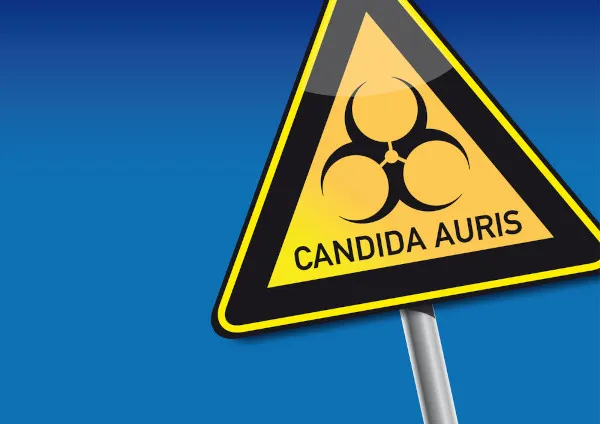
Candida auris has emerged as one of the most significant concerns in modern medicine, representing a serious threat to global health. First discovered in 2009, this species of fungus has rapidly spread through hospitals and clinics worldwide, causing outbreaks of infections that are difficult to treat due to its resistance to antifungal medications. In this article, we will explore what Candida auris is, why it is considered such a dangerous threat, and how the scientific community is addressing this growing challenge.
What is Candida Auris?
Candida auris is a type of yeast that can cause severe infections, primarily in hospital settings. Unlike other species of Candida, such as Candida albicans, Candida auris stands out for its ability to survive on hospital surfaces and for being resistant to multiple classes of antifungal drugs. This resistance makes treatment of infections extremely difficult and, in some cases, ineffective, leading to high mortality rates.
Origin and Spread
Since its discovery in the ear of a Japanese patient in 2009, Candida auris has spread rapidly, appearing in more than 40 countries. It is unclear exactly how this species emerged so suddenly and spread globally. However, it is believed that factors such as the overuse of antifungals in agricultural and hospital settings have contributed to its resistance and proliferation.

Why is Candida Auris a Global Health Threat?
Candida auris is a public health threat for several reasons, making it a global priority for the World Health Organization (WHO) and other health entities.
1. Drug Resistance
One of the biggest concerns about Candida auris is its resistance to multiple antifungal drugs, including the three main groups used to treat fungal infections: azoles, echinocandins, and polyenes. This means that in many cases, treatment options are limited, and doctors face significant challenges in eradicating the infection.
2. High Mortality Rate
Infections caused by Candida auris have a high mortality rate, ranging between 30% and 60%, especially among patients already hospitalized for other serious conditions. These infections can lead to severe complications, such as sepsis and multiple organ failure, worsening the clinical condition of patients.
3. Difficult to Diagnose
Another worrying factor is that Candida auris is difficult to diagnose correctly using conventional laboratory methods. Often, the species can be mistaken for other yeasts, leading to delays in diagnosis and inappropriate treatment, which can increase the spread of the fungus.
4. Prolonged Survival on Surfaces
Unlike other Candida species, Candida auris can survive for weeks on surfaces and hospital equipment, such as catheters and respirators. This makes it easier to transmit in hospital environments, where immunocompromised patients are more vulnerable. Candida auris outbreaks have been documented in intensive care units (ICUs) in several countries, creating a massive challenge for infection control.
Risk Factors for Candida Auris Infection
Certain groups of people are more vulnerable to Candida auris infections, especially those with compromised immune systems. The main risk factors include:
- Patients in Intensive Care Units (ICU): Patients in ICUs, especially those using catheters, feeding tubes, or mechanical ventilation, are at a higher risk of contracting Candida auris infections.
- Use of Broad-Spectrum Antibiotics or Antifungals: Prolonged use of antibacterial or antifungal medications can disrupt the body’s microbial flora, allowing Candida auris to proliferate.
- Chronic Diseases: Patients with diabetes, kidney disease, or other chronic health issues are more likely to develop severe infections.
- Recent Surgeries: Patients who have recently undergone invasive surgeries are also at a higher risk.

How is the Scientific Community Fighting Candida Auris?
Given the rapid rise of the Candida auris threat, scientists and healthcare professionals are taking steps to contain its spread and develop new treatments. Some of the most significant efforts include:
1. Development of New Antifungals
Due to Candida auris’ resistance to conventional antifungal treatments, there is a significant effort to develop new drugs that can effectively combat this fungus. Research is underway to create innovative compounds that can overcome resistance mechanisms.
2. Improvement in Diagnostic Methods
Advances in molecular diagnostic techniques are helping laboratories identify Candida auris more accurately and quickly. The use of technologies such as mass spectrometry and DNA sequencing allows for more effective identification, helping to prevent outbreaks in hospital settings.
3. Infection Control Measures
Health authorities worldwide are implementing strict infection control measures in hospitals to contain the spread of Candida auris. This includes frequent surface disinfection, the use of personal protective equipment (PPE), and the isolation of infected patients to prevent transmission.
4. Global Awareness
In addition to scientific and medical advancements, global awareness about Candida auris is crucial. Organizations such as WHO and the Centers for Disease Control and Prevention (CDC) have been alerting healthcare systems to the severity of the situation and promoting educational campaigns on the risks and prevention practices.
The Future of the Fight Against Candida Auris
The battle against Candida auris is far from over, but there is growing hope with scientific advances and increased international cooperation. However, it is important for governments, healthcare professionals, and the general public to be aware of the impact of this fungal threat and what can be done to prevent its spread.
The Role of Prevention
Prevention is key to controlling the spread of Candida auris. This includes not only hospital practices but also the proper use of antifungals and antibiotics to avoid the development of resistance. Educating healthcare professionals on diagnostic, treatment, and hospital infection prevention methods is also essential to mitigating the impact of this fungus.

Conclusion
Candida auris represents a grave threat to global health, being resistant to multiple antifungals, difficult to diagnose, and able to survive on surfaces for long periods. Its ability to cause fatal infections in hospital settings, where patients are especially vulnerable, makes it a formidable enemy in the fight against infectious diseases.
The global response to Candida auris must be swift and coordinated, with continuous efforts in scientific research, treatment development, and strict prevention measures. Only through such efforts can we contain this growing threat and protect the most vulnerable populations.
Candida Auris: A Grave Threat to Global Health – Boost Your Immune System Naturally with Food and Healthy Habits



